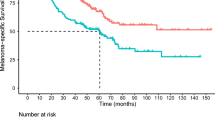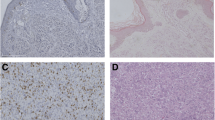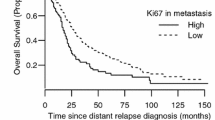Abstract
Background
The purpose of this work was to investigate the prognostic significance of Ki67 in acral melanoma (AM).
Patients and Methods
Ki67 values in primary lesions (pKi67) of 481 patients with primary non-metastatic AM (primary cohort) from three tertiary hospitals and in recurrent lesions (rKi67) of 97 patients (recurrent cohort) were recorded. The associations of p/rKi67 with clinicopathological features and prognosis were analyzed.
Results
In the primary cohort, high pKi67 group tended to have more ulceration, pT4, lymph node metastasis (LNM), nodal macrometastases, and recurrence (all P < 0.05). Logistic regression analysis revealed that pKi67 was significantly associated with pT4 and LNM (P = 0.004 and 0.027, respectively). Furthermore, both 5-year overall survival (OS) and recurrence-free survival (RFS) rates in high pKi67 group were significantly worse than those in moderate and low pKi67 groups (OS 47.8% versus 55.7 versus 76.8%, P = 0.002; RFS: 27.1 versus 42.8 versus 61.8%, P < 0.001). Similarly, in the recurrent cohort, the 5-year survival after recurrence (SAR) rates in high rKi67 group was significantly worse than those in moderate and low rKi67 groups (31.7 versus 47.4 versus 75%; P = 0.026). Stratified analysis also indicated a significant survival difference among pKi67 groups within various subgroups. Most importantly, multivariate Cox analysis demonstrated that pKi67 could be independently associated with OS and RFS, as well as rKi67 for SAR (all P < 0.05).
Conclusions
A high Ki67 value was significantly associated with adverse pathological and prognostic features in both primary and recurrent AM cohorts. Ki67 should be routinely evaluated to guide risk stratification and prognostic prediction.



Similar content being viewed by others
Data availability
The validity of this study was confirmed by depositing the key raw data on the Research Data Deposit (RDD) public platform (www.researchdata.org.cn; approval no. RDDA2023415390).
References
Karimkhani C, Green AC, Nijsten T, et al. The global burden of melanoma: results from the Global Burden of Disease Study 2015. Br J Dermatol. 2017;177(1):134–40.
Chinese guidelines for diagnosis and treatment of melanoma 2018 (English version). Chin J Cancer Res. 2019, 31(4):578-+
Cao W, Chen HD, Yu YW, Li N, Chen WQ. Changing profiles of cancer burden worldwide and in China: a secondary analysis of the global cancer statistics 2020. Chin Med J. 2021;134(7):783–91.
Huang K, Xu Y, Joseph R, Bagaria SP, Misra S, Chen Y. Comparative analysis of acral melanoma in Chinese and Caucasian patients. Ann Surg Oncol. 2019;26:S158–9.
Newell F, Wilmott JS, Johansson PA, et al. Whole-genome sequencing of acral melanoma reveals genomic complexity and diversity. Nat Commun. 2020. https://doi.org/10.1038/s41467-020-18988-3.
Cheraghlou S, Ugwu N, Girardi M. Sentinel lymph node biopsy positivity in patients with acral lentiginous and other subtypes of cutaneous melanoma. JAMA Dermatol. 2022;158(1):51–8.
Tas F, Erturk K. Major histotypes in skin melanoma: nodular and acral lentiginous melanomas are poor prognostic factors for relapse and survival. Am J Dermatopathol. 2022;44(11):799–805.
Mandala M, Rutkowski P, Galli F, et al. Acral lentiginous melanoma histotype predicts outcome in clinical stage I-II melanoma patients: an international multicenter study. Esmo Open. 2022;7(3):100469.
Wei X, Chen Y, Yao H, et al. Prognostic impact of Breslow thickness in acral melanoma: a retrospective analysis. J Am Acad Dermatol. 2022;87(6):1287–94.
Kolberg-Liedtke C, Hussein S, Bankfalvi A, et al. The role of Ki67 in involved lymph nodes as a predictive biomarker for response to neoadjuvant chemotherapy in patients with early breast cancer. J Clin Oncol. 2021;39(15):e12553.
Wang W, Zhang Y, Peng Y, et al. A Ki-67 Index to predict treatment response to the capecitabine/temozolomide regimen in neuroendocrine neoplasms: a retrospective multicenter study. Neuroendocrinology. 2021;111(8):752–63.
Tuninetti V, Ghisoni E, Pignata S, et al. Ki67 as a predictor of response to PARP inhibitors in platinum sensitive BRCA wild type ovarian cancers: MITO 37 retrospective study. Ann Oncol. 2022;33(7):S816–S816.
Ma X, Wu Y, Zhang T, et al. Ki67 Proliferation index as a histopathological predictive and prognostic parameter of oral mucosal melanoma in patients without distant metastases. J Cancer. 2017;8(18):3828–37.
Tang L, Wei X, Li C, et al. Proliferation marker Ki67 as a stratification index of adjuvant chemotherapy for resectable mucosal melanoma. Front Oncol. 2022;2022:12.
Gimotty PA, Van Belle P, Elder DE, et al. Biologic and prognostic significance of dermal Ki67 expression, mitoses, and tumorigenicity in thin invasive cutaneous melanoma. J Clin Oncol. 2005;23(31):8048–56.
Jurmeister P, Bockmayr M, Treese C, et al. Immunohistochemical analysis of Bcl-2, nuclear S100A4, MITF and Ki67 for risk stratification of early-stage melanoma - A combined IHC score for melanoma risk stratification. J Der Deutschen Dermatologischen Gesellschaft. 2019;17(8):800–9.
Nielsen PS, Riber-Hansen R, Jensen TO, Schmidt H, Steiniche T. Proliferation indices of phosphohistone H3 and Ki67: strong prognostic markers in a consecutive cohort with stage I/II melanoma. Mod Pathol. 2013;26(3):404–13.
Swetter SM, Thompson JA, Albertini MR, et al. Melanoma: cutaneous, version 2.2021 featured updates to the NCCN guidelines. J Nat Compr Cancer Netw. 2021;19(4):3655.
Gershenwald JE, Scolyer RA, Hess KR, et al. Melanoma staging: evidence-based changes in the American Joint Committee on Cancer eighth edition cancer staging manual. Ca-a Cancer J Clin. 2017;67(6):472–92.
Blankenstein SA, van Akkooi ACJ. Adjuvant systemic therapy in high-risk melanoma. Melanoma Res. 2019;29(4):358–64.
Camp RL, Dolled-Filhart M, Rimm DL. X-tile: a new bio-informatics tool for biomarker assessment and outcome-based cut-point optimization. Clin Cancer Res. 2004;10(21):7252–9.
Ben-Izhak O, Bar-Chana M, Sussman L, et al. Ki67 antigen and PCNA proliferation markers predict survival in anorectal malignant melanoma. Histopathology. 2002;41(6):519–25.
Vaisanen A, Kuvaja P, Kallioinen M, Turpeenniemi-Hujanen T. A prognostic index in skin melanoma through the combination of matrix metalloproteinase-2, Ki67, and p53. Hum Pathol. 2011;42(8):1103–11.
Taylor RC, Patel A, Panageas KS, Busam KJ, Brady MS. Tumor-infiltrating lymphocytes predict sentinel lymph node positivity in patients with cutaneous melanoma. J Clin Oncol. 2007;25(7):869–75.
Paek SC, Griffith KA, Johnson TM, et al. The impact of factors beyond Breslow depth on predicting sentinel lymph node positivity in melanoma. Cancer. 2007;109(1):100–8.
Murali R, Desilva C, Thompson JF, Scolyer RA. Non-sentinel node risk score (N-SNORE): a scoring system for accurately stratifying risk of non-sentinel node positivity in patients with cutaneous melanoma with positive sentinel lymph nodes. J Clin Oncol. 2010;28(29):4441–9.
Matar R, Boughey JC, Hoskin T, Goetz MP. Neoadjuvant chemotherapy and nodal response rates in luminal breast cancer: effects of age and tumor ki67. Ann Surg Oncol. 2022;29(SUPPL 2):338–9.
Wei X, Wu D, Chen Y, et al. Prognostic value of ulceration varies across Breslow thicknesses and clinical stages in acral melanoma: a retrospective study. Br J Dermatol. 2022;186(6):977–87.
Teramoto Y, Keim U, Gesierich A, et al. Acral lentiginous melanoma: a skin cancer with unfavourable prognostic features. A study of the German central malignant melanoma registry (CMMR) in 2050 patients. Br J Dermatol. 2018;178(2):443–51.
Wei X, Wu D, Li H, et al. The clinicopathological and survival profiles comparison across primary sites in acral melanoma. Ann Surg Oncol. 2020;27(9):3478–85.
Author information
Authors and Affiliations
Contributions
Dandan Li and Yao Liang were responsible for protocol development; Chengcai Liang, Yin Liang, Yang Xie, Naiyu Lin, and Huajie Guan for data collection and analysis; Chengcai Liang, Dandan Li, and Yao Liang for manuscript writing; and Wanming Hu and Yuanxiang Guan for manuscript editing. All authors agreed to be responsible for all aspects of the study. All authors read and approved the final manuscript.
Corresponding author
Ethics declarations
DISCLOSURE
The authors declare that they have no conflicts of interest.
Additional information
Publisher's Note
Springer Nature remains neutral with regard to jurisdictional claims in published maps and institutional affiliations.
Supplementary Information
Below is the link to the electronic supplementary material.
Rights and permissions
Springer Nature or its licensor (e.g. a society or other partner) holds exclusive rights to this article under a publishing agreement with the author(s) or other rightsholder(s); author self-archiving of the accepted manuscript version of this article is solely governed by the terms of such publishing agreement and applicable law.
About this article
Cite this article
Liang, C., Li, D., Liang, Y. et al. Prognostic and Predictive Significance of Ki67 in Primary Non-metastatic or Recurrent Acral Melanoma: Evidence from a Multicenter Retrospective Study. Ann Surg Oncol (2024). https://doi.org/10.1245/s10434-024-15327-4
Received:
Accepted:
Published:
DOI: https://doi.org/10.1245/s10434-024-15327-4




